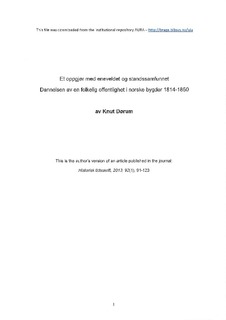| dc.contributor.author | Dørum, Knut | |
| dc.date.accessioned | 2015-02-18T12:12:30Z | |
| dc.date.available | 2015-02-18T12:12:30Z | |
| dc.date.issued | 2013 | |
| dc.identifier.citation | Dørum, K. (2013). Et oppgjør med eneveldet og standssamfunnet : dannelsen av en folkelig offentlighet i norske bygder 1814-1850. Historisk Tidsskrift, 92(1), 91-123. | nb_NO |
| dc.identifier.issn | 0018-263X | |
| dc.identifier.uri | http://hdl.handle.net/11250/276653 | |
| dc.description | Author's version of an article in the journal: Historisk tidsskrift. Also available from the publisher at: http://www.idunn.no/ht/2013/01/et_oppgjr_med_eneveldet_og_standssamfunnet_-_dannelsen_av_ | nb_NO |
| dc.description.abstract | Previous studies of political culture in Norway in the period 1814–1850 have mainly concentrated on events and movements surrounding the Storting and the bourgeoisie in large urban areas. Exceptions were formation of the peasants’ opposition in the Storting and of the radical lower class movement under the guidance of Marcus Thrane in 1848–1851. Little attention has been paid to the development of a popular rural public sphere and the early democratization of local communities in Norway in the period 1814–1850. This article argues that democratization and politicization taking place after 1814 intensified in the 1830s and 1840s and encompassed large numbers of the rural lower classes (including servants, cottars and craftsmen). These processes occurred more rapidly and to a far greater extent than previous research has maintained – areas such as inns, tavernas, small taprooms, the church Green as well as private homes and houses were all given new meanings and functions and, as a result, became informal political arenas that differed from those existing before 1814. Groups and individuals from various social backgrounds came together to discuss and identify societal issues of common interest and thereby to influence political action and decision making. In addition to spreading liberal political ideas, this led to widespread literacy and the distribution of letters, books, pamphlets, handwritten and printed protest documents and newspapers, especially in regard to important school reforms. In the decades after 1814, considerable efforts made to increase local self-government were often initiated from below; these materializing in new political institutions based on popular representation and heralding the ensuing great communal reform in 1837 dictating that local law devolve a substantial amount of power from local authorities to popular local bodies. This combination of forces led to vastly popular political radicalization and strong opposition to the Establishment. The present article tones down the common description of peasants as traditional and restricted in their opposition to State officials (the embetsmenn), and also the established view that politicization reached the peasant elite or upper social strata in the local communities first. Furthermore, the article underlines that 1814 was a watershed year characterized by relatively rapid formation of a socially inclusive rural public sphere whose political implications parallel what we know took place in contemporary England and France. | nb_NO |
| dc.language.iso | nob | nb_NO |
| dc.publisher | Universitetsforlaget | nb_NO |
| dc.subject | democratization | nb_NO |
| dc.subject | local self-government | nb_NO |
| dc.subject | political culture | nb_NO |
| dc.subject | popular representation | nb_NO |
| dc.title | Et oppgjør med eneveldet og standssamfunnet : dannelsen av en folkelig offentlighet i norske bygder 1814-1850 | nb_NO |
| dc.type | Journal article | nb_NO |
| dc.type | Peer reviewed | nb_NO |
| dc.subject.nsi | VDP::Humanities: 000::History: 070::Modern history (after 1800): 083 | nb_NO |
| dc.subject.nsi | VDP::Humanities: 000::History: 070::Political history: 071 | nb_NO |
| dc.source.pagenumber | 91-123 | nb_NO |
| dc.source.volume | 92 | nb_NO |
| dc.source.journal | Historisk tidsskrift | nb_NO |
| dc.source.issue | 1 | nb_NO |
